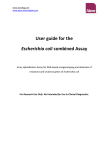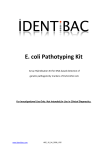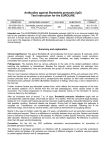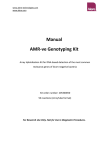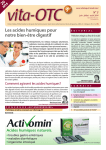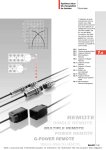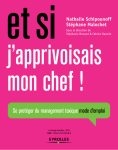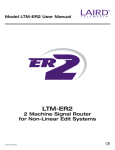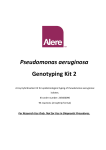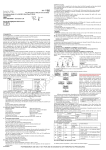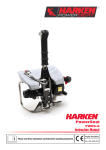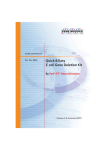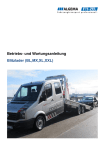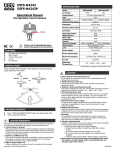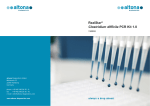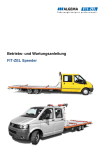Download Kit Manual - Alere Technologies GmbH
Transcript
www.alere-technologies.com www.alere.com Manual E. coli Genotyping Kit Array Hybridisation Kit to detect important virulence genes of Escherichia coli Kit order number: 205400050 50 reactions (ArrayTube format) For Research Use Only. Not for Use in Diagnostic Procedures. www.alere-technologies.com www.alere.com CONTENT BACKGROUND........................................................................................................................... 1 GENERAL INSTRUCTIONS FOR USE ............................................................................................... 2 I NTENDED USE .......................................................................................................................... 2 SPECIFICATI ONS ......................................................................................................................... 2 TECHNICAL S UPPORT ................................................................................................................... 2 SAFETY PRECAUTIONS .................................................................................................................. 2 MATERI AL S AFETY DATA SHEETS (MSDS) .......................................................................................... 3 SHIPPING PREC AUTI ONS ............................................................................................................... 3 DEVICES, SOFTWARE AND REAGENTS........................................................................................... 4 SOFTW ARE I NSTALLATI ON ............................................................................................................. 4 Assay Plugin and SDK for the ArrayMate ................................................................................ 5 Test the AssayPlugin ........................................................................................................... 6 KIT C OMP ONENTS, STORAGE AND STABILITY ........................................................................................ 7 COMP ONENTS REQUIRED BUT NOT PROVIDED ...................................................................................... 8 PROTOCOLS ............................................................................................................................ 10 CULTURING AND HARVESTING BACTERIAL CELLS ................................................................................. 10 EXTRACTION OF DNA ................................................................................................................ 10 DNA Extraction via Spin Columns (e.g. Qiagen DNeasy Blood&Tissue)....................................... 10 DNA Extraction by Heat Lysis .............................................................................................. 13 LINEAR AMPLIFICATI ON AND I NTERNAL B IOTIN LABELLING ...................................................................... 14 HYBRIDISATION ....................................................................................................................... 14 General Remarks - Handling of Arrays.................................................................................. 14 General Remarks - Handling of Liquids ................................................................................. 15 General Remarks – the Substrate (Precipitating Dye) D1......................................................... 16 General Remarks - Thermoshakers ...................................................................................... 16 D ATA ANALYSIS ....................................................................................................................... 20 Starting the ArrayMate Reader ........................................................................................... 20 Worklist .......................................................................................................................... 21 Data Acquisition in the ArrayMate Reader............................................................................ 22 Results ............................................................................................................................ 24 Export of Test Results ........................................................................................................ 28 TROUBLESHOOTING................................................................................................................. 30 STAINI NG C ONTROL .................................................................................................................. 30 I MAGE QUALITY ....................................................................................................................... 30 DNA QUALITY ........................................................................................................................ 31 PHYSICAL DAMAGE TO THE ARRAY ................................................................................................. 31 AMBIGUOUS RESULTS ................................................................................................................ 31 ADDITIONAL INFORMATION ..................................................................................................... 32 WARRANTY ............................................................................................................................ 32 D ISCLAIMER ........................................................................................................................... 32 QUALITY C ONTROL ................................................................................................................... 32 LIST OF C OMP ONENTS FOR S EPARATE O RDER .................................................................................... 33 CONTAC T .............................................................................................................................. 33 LITERATURE ............................................................................................................................ 34 UPDATES & SOFTWARE ............................................................................................................ 35 APPENDIX 1 - FLOW CHART....................................................................................................... 36 APPENDIX 2 – IMAGES FOR TROUBLESHOOTING ......................................................................... 37 APPENDIX 3 - GENE LIST ........................................................................................................... 39 www.alere-technologies.com BACKGROUND The ALERE E. coli Genotyping Kit allows a quick and simple method to detect important virulence genes of Escherichia coli (E. coli). RNA-free, unfragmented genomic DNA of a pure and monoclonal E. coli colony material is amplified approximately 50-fold and internally labelled with biotin-11-dUTP using a linear amplification protocol. In contrast to standard PCR, a multiplex primer extension reaction is performed with two nested primers per target in each cycle. Two-versus-one primer for each target increase and synchronize the yield of biotin labelled single stranded (ss) DNA product for all markers. This allows a simultaneous sequence specific labelling and amplification of an essentially unlimited number of targets. However, sensitivity is lower than in a standard PCR (whereas contamination with amplicons is nearly impossible) and for that reason the method is restricted to clonal colony material and cannot be performed on samples such as swabs or other patient samples. Resulting biotin labelled ssDNA is transferred and hybridised to DNA oligonucleotide microarrays with 124 probes for different genetic markers plus controls. All of them are spotted in two spots each. The array contains markers for: - family, genus and species identification - toxins (i.e. shiga toxin) - fimbrial associated proteins (i.e. bacterial adhesins) - secretion systems (i.e. type III secretion system) - serine protease autotransporters (SPATE) - staining controls using biotinylated control spots. E. coli Genotyping Kit 05_16_04_0006_V06_Manual_E.coli_Genotyping_Kit 1 www.alere-technologies.com GENERAL INSTRUCTIONS FOR USE Intended Use For Research Use Only. Not for Use in Diagnostic Procedures. This assay allows genotypic characterisation of important virulence genes of E. coli. It cannot be used for other bacteria than E. coli. Specifications Upon receipt, the assay components need to be stored at different temperatures as specified on the package insert. The assay is to be performed at an ambient temperature of 18°C to 28°C. Technical Support If you require any further information on this product please contact: Email: [email protected] Phone: +49 (0) 36 41 3111-155 Fax: + 49 (0) 36 41 3111-120 For up-to-date information regarding the kit, please visit our website at http://alere-technologies.com/en/products/lab-solutions/e-coli/e-coli-genotyping-kit.html Safety Precautions The assay is intended for use by personnel that are trained in microbiological and molecular methods. Preparation of DNA from pure E. coli colonies (clones) requires expertise in microbiology and the local regulations for handling of pathogenic microorganisms (biosafety level 2) are to be adhered to. Isolated, cell-free E. coli DNA may be processed without further biosafety precautions, although contamination with E. coli or other bacteria needs to be ruled out. Always wear protective clothing as required for laboratory work according to your local regulations. E. coli Genotyping Kit 05_16_04_0006_V06_Manual_E.coli_Genotyping_Kit 2 www.alere-technologies.com Material Safety Data Sheets (MSDS) According to OSHA 29CFR1910.1200, Commonwealth of Australia [NOHSC: 1005, 1008(1999)] and the latest regulations (EC) 1272/2008 (CLP) and 1907/2006 (REACH), the enclosed reagents do not require a Material Safety Data Sheet (MSDS), except Hybridisation Buffer C1. The MSDS can be downloaded via our website from any lab solutions product page (e.g. http://aleretechnologies.com/en/products/lab-solutions.html). All other reagents do not contain more than 1 % of a component classified as hazardous and do not contain more than 0.1 % of a component classified as carcinogenic. Nevertheless, the buffers may cause irritation if they come into contact with eyes or skin, and may cause harm if swallowed. The regular precautions associated with laboratory work should be obeyed (e.g., wear protective goggles, gloves and lab coat and avoid contact with the reagents). If liquid is spilled, clean with a disinfectant and/ or laboratory detergent and water. Alere assumes no liability for damage resulting from handling or contact with these products. If you have any questions please contact our Technical Support (see above). Shipping Precautions RID/ADR: “Kein Gefahrgut”/ No dangerous goods IMDG: No dangerous goods IATA: No dangerous goods E. coli Genotyping Kit 05_16_04_0006_V06_Manual_E.coli_Genotyping_Kit 3 www.alere-technologies.com DEVICES, SOFTWARE AND REAGENTS ArrayMate Reader (to be ordered separately, for details see below) Alternatively, Reader ATR03 (to be ordered separately, for details see below) Iconoclust software (provided with the reader) Report Generator (optional) Whilst the E. coli Genotyping assay runs both on the ArrayMate Reader and on the ATR03 reader, respectively, this manual describes the reading of proce ssed AT on the ArrayMate reader only. If you want to use ATR03, please refer to the latest version of the ATR03 manual or contact us. Assay specific software (plug-in) is delivered with the reader or can be downloaded from our website, where it will occasionally be updated. The ArrayMate Reader by default has all software on board. However, the E. coli Genotyping assay specific package might be missing, e.g., if you obtained the device for the use with another assay. Then you may need to install it separately. It will be provided upon kit order, and can also be downloaded from our website as discussed above. No issues regarding compatibility of software have been observed with the ArrayMate device. The ATR03 reader requires several pieces of software to be installed on an external PC (please refer to the latest version of the ATR03 manual for details). The E. coli Genotyping assay specific software is not compatible with iconoclust versions older than version 4.4. Software Installation For analysis of the final image of the DNA microarray on the ArrayMate specific software plugin is required. This software plugin can be downloaded from our webs ite www.alereH technologies.com under Downloads (plug-ins). Please install it on your reader according to the following instructions. E. coli Genotyping Kit 05_16_04_0006_V06_Manual_E.coli_Genotyping_Kit 4 www.alere-technologies.com Assay Plugin and SDK for the ArrayMate The following instruction describes the installation of the AssayPlugin and ArrayMate installation software (SDK). 1. Download the AssayPlugin and the ArrayMate SDK from http://aleretechnologies.com/en/products/lab-solutions/e-coli/e-coli-genotyping-kit.html 2. Copy downloaded files (Plugin and SDK setup) to an USB Memory Stick and connect it to the ArrayMate. 3. Log on as user admin to the ArrayMate (default password: 12345). 4. Open the Windows Explorer and navigate to the downloaded setup files. 5. Start installation: double click on setup file of the AssayPlugin. E. coli Genotyping Kit 05_16_04_0006_V06_Manual_E.coli_Genotyping_Kit 5 www.alere-technologies.com 6. The welcome screen of the setup appears. 7. Follow the instructions and press Finish to complete the installation. 8. Repeat this process for the SDK Setup. 9. Log off and log in again as User R&D (default password: abcde). Test the AssayPlugin The Software installation can be tested with the unprocessed Array by the fol lowing steps: 1. Log on to the ArrayMate in User R&D Mode (default password: abcde) and start a New Run. 2. Choose automatic detection in Experiment Infos and press Next. Place the ArrayTube rack with an unprocessed ArrayTube into the ArrayMate than press Next. After the Experiment Run the ArrayMate automatically enters the Archive mode and displays the results of the last experiment. 3. Each cell of the columns image, raw data and results must contain an “X”. Otherwise, please retry the installation process of the AssayPlugin and the installatio n software (SDK). E. coli Genotyping Kit 05_16_04_0006_V06_Manual_E.coli_Genotyping_Kit 6 www.alere-technologies.com Kit Components, Storage and Stability All reagents are provided in surplus (see below). If necessary, all components may be ordered separately; please refer to the catalogue reference numbers (Cat#) at the end of this manual. For pricing please contact your local representative or our customer service, respectively. The expiry date can be found on each bottle and on the outer packaging. All components have been stability tested for short term shipment (<1 week) at ambient temperature (< 37°C). The assay components with limited stability are D1 and C3. The other kit components have proven to be stable six months post expiry. Cell Lysis (optional) A1: Lysis Buffer (Cat# 245101000) Store at 18°C to 28°C (ambient temperature). Surplus: 200 %. A2: Lysis Enhancer (lyophilised, Cat# 245102000) Store at 18°C to 28°C (ambient temperature). Centrifuge A2 tubes shortly prior to opening. Add 200 µl Buffer A1 to Lysis Enhancer before use. Mix well and store for less than 1 week at 2°C to 8°C. Sufficient for 96 isolations. DNA Labelling and Amplification B1EC: Labelling Buffer, Store at 2°C to 8°C. Surplus: 45 %. B2: Labelling Enzyme, Store at 2°C to 8°C. Surplus: 300 %. E. coli Genotyping Kit 05_16_04_0006_V06_Manual_E.coli_Genotyping_Kit 7 www.alere-technologies.com Hybridisation and Detection • ArrayTubes (10 x 5 samples), protected against light and sealed under inert gas. Store at 18°C to 28°C. After opening, tubes are to be used within two weeks. Close unused ArrayTubes, protect them against humidity and dust and store in the dark. Avoid ANY touching or scratching the microarray on the bottom of the vial. Please note: Do not store or handle unused wells above 60 % relative humidity since this may irreversibly corrode the spots. • C1: Hybridisation Buffer. Store at 18°C to 28°C. Protect against sunlight. Surplus: 100 %. • C2: Washing Buffer 1. Store at 18°C to 28°C. Surplus: 140 %. • C3: 100x HRP Conjugate. Store at 2°C to 8°C. Surplus: 300 %. • C4: Conjugate Buffer. Store at 18°C to 28°C. Surplus: 500 % • C5: Washing Buffer 2. Store at 18°C to 28°C. Surplus: 140 %. • D1: Horseradish Peroxidase Substrate. Store at 2°C to 8°C. Protect against direct sunlight. Surplus: 200 %. Optional: CMEDL: Reference DNA from E. coli EDL933 (GenBank accession number NC_002655.2), cDNA = 0.1-0.4 µg/µl. Store at 2°C to 8°C. Sufficient for 5-6 tests. Components required but not provided Growth media for the cultivation of E. coli. The test should be performed with colonies harvested from 2xTY or Columbia blood agar. Liquid media should not been used because contaminations or mixed cultures cannot be ruled out easily. Equipment and consumables needed for the cultivation of E. coli (incubator, inoculation loops, Petri dishes) DNA preparation kits: The assay has been tested with the DNeasy Blood & Tissue Kit from Qiagen (Cat# 69504) and High Pure DNA Isolations Kit from Roche (Cat# 11796828001). E. coli Genotyping Kit 05_16_04_0006_V06_Manual_E.coli_Genotyping_Kit 8 www.alere-technologies.com Please note: The DNA specimen needs to be free of RNA. Recommendation: a pretreatment using the cell lysis components A1/A2 (see below) or a standard RNase A treatment during DNA preparation. 1x PBS RNAse A (we recommend Qiagen’s RNase A solution, 100 mg/ml, Qiagen Cat# 19101) Equipment needed for DNA isolation, e.g. pipettes, centrifuge, thermoshaker or automated device (see above) Photometer (OD 260 nm) for measuring the concentration of DNA Equipment for non-denaturing agarose DNA gel electrophoresis for quality control of DNA Thermocycler for PCR Thermoshaker Please note: We recommend the Eppendorf’s Thermomixer Comfort equipped with a heating block for 1.5ml tubes. Pipettes: suitable for 1 µl-5 µl volumes, 90 µl, 100 µl, 200 µl, 1000 µl Multichannel Pipettes for 100-200 µl Sterile reaction vials suitable for PCR (VWR Cat# 732-0098) Ultrapure (PCR grade) water Pasteur pipettes (VWR Cat# 612-2856) E. coli Genotyping Kit 05_16_04_0006_V06_Manual_E.coli_Genotyping_Kit 9 www.alere-technologies.com PROTOCOLS Culturing and Harvesting Bacterial Cells E. coli strains are potential pathogens. All procedures for cultivation of the bacterium and DNA preparation need to be performed by properly trained staff in a biosafety level 2 facility. Grow E. coli on 2xTY or Columbia blood agar (overnight at 37°C or 48 h at room temperature). Make sure that you have a pure, monoclonal culture of E. coli. Contamination with other bacteria, especially with other non-fermenting Gram-negative rods needs to be strictly avoided. If necessary, sub-clone, and incubate again. Extraction of DNA The required sample type for the E. coli Genotyping Kit is 0.5-2 µg (cDNA = 0.1-0.4 µg/µl) of intact genomic DNA from a single clone. The DNA specimen needs to be free of RNA and it should not be fragmented. This can be determined by agarose gel electrophoresis. DNA should not be prepared by disrupting E. coli cells using bead beaters, ultrasonication or aggressive chemicals such as in alkaline lysis protocols. Most performance problems with the E. coli Genotyping Kit are due to insufficient amounts or quality of DNA preparation. We therefore strongly recommend following the protocols outlined below. The use of automated systems for DNA preparation (EZ1, Qiacube, Magnapure etc.) has not yet been systematically evaluated with this assay. While there are positive experiences with some of our other assays, we recommend testing some known strains for evaluation prior to routine use of these systems. Lysis steps and addition of RNase should be performed as described below before loading the samples in an automated system for DNA preparation. DNA Extraction via Spin Columns (e.g. Qiagen DNeasy Blood&Tissue) Add an inoculating loop full of monoclonal colony material of the E. coli isolate to 0.2 ml 1xPBS and vortex thoroughly. E. coli Genotyping Kit 05_16_04_0006_V06_Manual_E.coli_Genotyping_Kit 10 www.alere-technologies.com Loop empty Loop full It is important to harvest enough bacteria; this is a prerequisite for extraction of a sufficient amount of DNA. Take an inoculating loop of 1 mm diameter filled with bacteria as shown in the left picture. Optional cell lysis with A1/A2 reagent (instead of 1xPBS): Centrifuge A2 tube shortly, open it, add 0.2 ml of Lysis Buffer A1 to Lysis Enhancer A2 and dissolve. Add an inoculating loop full of monoclonal colony material of the E. coli isolate to this A1/A2 reagent and vortex thoroughly. Incubate the colony material of the E. coli isolate in A1/A2 for 30-60 min at 37°C and 550 rpm in the thermoshaker. Proceed with the DNA preparation protocol of the DNA preparation kit. For the Qiagen DNeasy Blood&Tissue Kit that is as follows: Add 20 µl proteinase K (Qiagen Kit, or equivalent) and add 200 µl buffer AL (Qiagen Kit). Vortex briefly or shake vigorously. Incubate for 30-60 min at 56°C and 550 rpm in the thermoshaker. important: If A1/A2 reagent not used, add now 4 μl RNase A (100 mg/ml), mix by vortexing, and incubate for 2 min at room temperature before continuing. Add 200 µl ethanol (96-100 %). Vortex the sample and centrifuge shortly. Transfer the complete content of the tube (including any precipitate) into a spin column that is placed in a 2 ml collection tube. E. coli Genotyping Kit 05_16_04_0006_V06_Manual_E.coli_Genotyping_Kit 11 www.alere-technologies.com Centrifuge at room temperature, time and speed need to be determined depending on viscosity of the sample and type of centrifuge used (e.g., 1 min at 8000 rpm). All liquid should be collected in the collection tube afterwards. Discard collection tube with liquids. Place the spin column in a new 2 ml collection tube (provided with the Qiagen kit). Add 500 µl Buffer AW1. Centrifuge at room temperature (e.g., 1 min at 8000 rpm). Discard collection tube with liquids. Place the spin column in a new 2 ml collection tube (provided with the Qiagen kit). Add 500 µl Buffer AW2. Centrifuge at room temperature, the membrane of the spin column should be dry, and all liquid should be in the collection tube (e.g., 3 min at 14000 rpm). Discard collection tube with liquids. Place the spin column in a clean 1.5 ml tube (not provided with the Qiagen kit). Add 50 µl Buffer AE (or PCR grade distilled water) directly onto the membrane of the spin column. Incubate at room temperature for 5 min to elute DNA. Centrifuge (e.g., 1 min at 8000 rpm). Optional: add another 50 µl Buffer AE (or PCR grade distilled water) directly onto the membrane, incubate at room temperature for 1-5 min and centrifuge again. Discard the spin column. Please note: Ethanol from Washing Buffers strongly inhibits the enzymes used in the assay. Such contamination might occur during elution of prepared DNA by drops adhering to the funnel of the spin columns. Thus these funnels should be gently touched and tried with sterile filter paper or wipes prior to the elution step. E. coli Genotyping Kit 05_16_04_0006_V06_Manual_E.coli_Genotyping_Kit 12 www.alere-technologies.com Alternatively, prepared DNA can shortly be heated to evaporate ethanol (e.g., 10 min at 70°C with open lid). Check for DNA integrity and absence of RNA (e.g., agarose gel). If necessary, yo u might perform another digestion step with additional RNase A (not provided). Measure DNA concentration (A 260 method), it shouldn´t be less than 0.1 µg/µl. The concentration might be increased by heating and evaporation of water, or by using a speed vac centrifuge. DNA Extraction by Heat Lysis Please note: Only a fresh overnight culture can be used. After DNA extraction by heating the linear amplification must be done immediately. Storage of extracted DNA is not recommended. Add a 1 µl inoculating loop (Please Note: do not use too much culture material, see Figure below) of a monoclonal E. coli isolate to 50 µl PCR-grade distilled water and vortex thoroughly. Incubate at 99°C, 15 min at 550 rpm in a thermoshaker. Centrifuge for 5 min at 13,600 rpm at room temperature. Carefully pipette 25 µl supernatant into a new 1.5 ml tube and discard the old tube with the pellet. Add 0.25 µl RNase A (not provided / see above) with a stock concentration of 1 mg/ml. Incubate at 37°C, 5 min at 550 rpm in a thermoshaker. Use 5 µl of this DNA suspension for the linear amplification and internal Biotin labelling process. E. coli Genotyping Kit 05_16_04_0006_V06_Manual_E.coli_Genotyping_Kit 13 www.alere-technologies.com Linear Amplification and Internal Biotin Labelling Please keep in mind the limited surplus of reagents whilst pipetting. The surplus of B1EC labelling reagent is 45 %. Prepare a Master Mix by combining 4.9 µl of B1EC labelling reagent and 0.1 µl of B2 (DNA polymerase) per sample. Add 5 µl of E. coli DNA (cDNA = 0.1-0.4 µg/µl) prepared as described above to 5 µl of the Master Mix (B1EC/B2). Do not forget to label the vial! Perform amplification in a pre-programmed thermocycler (e.g., Eppendorf Mastercycler gradient with heated lid) according to following protocol: Pre-heat cover/lid to 105°C 300 sec at 96°C 20 sec at 50°C 50 cycles with 40 sec at 72°C 60 sec at 96°C Cool down to 4°C, hold The amplification products can be stored frozen until usage. Please note: When using another device, some adaptations might be necessary. Before starting routine use, please test the protocol with a few known reference strains and the control DNA (CM) supplied with the kit. Hybridisation General Remarks - Handling of Arrays Never touch the array surface! Avoid complete drying of the array surface during processing! Do not allow it to stay without liquid for more than two minutes! E. coli Genotyping Kit 05_16_04_0006_V06_Manual_E.coli_Genotyping_Kit 14 www.alere-technologies.com Never rinse the wells with distilled water after the hybridisation step, only use C2 Washing Buffer! Always label your ArrayTubes with a laboratory marker at the recommended position. Never label them on the bottom or across the data matrix barcode! This may cause an error. Avoid contact of data matrix barcode with organic solvents! The ArrayMate needs the information encoded in the data matrix to perform the assay and the analysis afterwards. Avoid touching the bottom of the microarray and keep it clean. General Remarks - Handling of Liquids We recommend the use of a multichannel pipette and reagent reservoirs. Please keep in mind the limited surplus of C1 (100 %). We strongly recommend that the liquid is removed by pipetting. Fine tipped soft, disposable Pasteur pipettes are suited best (such as VWR Cat# 612-2856). Always place the pipette tip at the cavity between the array and the wall of the reagent well. If you touch the array surface, probes may be scratched off and this may cause an error. E. coli Genotyping Kit 05_16_04_0006_V06_Manual_E.coli_Genotyping_Kit 15 www.alere-technologies.com General Remarks – the Substrate (Precipitating Dye) D1 An appropriate amount of substrate (precipitating dye) should be filled into an Eppendorf tube and taken out of the refrigerator when starting the procedure allowing it to pre -warm to room temperature/25°C. Cold D1 may yield weak signals. D1 should be centrifuged (1 min, 13,000 rpm) prior to use to remove bubbles as well as possible precipitates. Triggered by peroxidase, in case of positive reactions, the dye precipitates but it is not covalently bound. The precipitate can be dissolved by vigorous shaking. Thus the arrays must not be shaken, dropped or moved abruptly during the staining procedure and afterwards. After completion of staining, do not remove reagent D1 and scan immediately. The dye precipitate fades slowly in presence of liquids. General Remarks - Thermoshakers The correct temperature within the vessels is essential; therefore always use the appropriate equipment for heating. Because of a possibly inhomogeneous distribution of the temperature within the heating block and because of possible differences between displayed and actual temperatures, the use of different brands of thermoshakers might affect test performance. We tested the assay with BioShake iQ by Quantifoil Instruments (http://www.qinstruments.com/) equipped with a customised heating block designed to fit ArrayTubes and Eppendorf’s Thermomixer Comfort, equipped with a heating block for 1.5 ml Eppendorf tubes. Thus we recommend the use of either device. When using other devices, some modifications to the protocol might be necessary. Before starting routine use, please test the protocol with a few known reference strains or the control DNA supplied with the kit. E. coli Genotyping Kit 05_16_04_0006_V06_Manual_E.coli_Genotyping_Kit 16 www.alere-technologies.com Preparation of the hybridisation mixture Pre-heat the thermoshaker to 55°C. Add 90 µl of buffer C1 to each labelling product, mix gently (vigorous mixing results in foaming) and put aside. Pre-washing of the arrays (2 washing steps) Remove the ArrayTube from the bag (open the bag at its predetermined breaking point). Add 500 µl of ultrapure water to each tube. Incubate in the thermoshaker at 55°C, 550 rpm for 2 minutes. Remove and discard the water WITHOUT TOUCHING THE ARRAY SURFACE. Add 500 µl buffer C1 to each tube. Incubate in the thermoshaker at 55°C, 550 rpm for 4 minutes. Remove and discard buffer C1. Proceed promptly (hybridisation mixtures must be ready when buffer C1 is removed). Hybridisation Transfer each hybridisation mixture (100 µl) to a prepared ArrayTube (avoid extensive foaming). Incubate in the thermoshaker at 55°C, 550 rpm for 60 minutes. Note: Meanwhile, login to the ArrayMate device and prepare your worklist (see section “worklist” S. 21) Dilute Streptavidin-Horseradish-Peroxidase (C3, C4) – HRP-conjugate Combine reagent C3 (Streptavidin-Horseradish-Peroxidase) and Buffer C4 in a ratio of 1:100, the mixture is stable for 1 day at room temperature; C3 is delivered with a surplus of 300 %, C4 is delivered with a surplus of 500 %. E. coli Genotyping Kit 05_16_04_0006_V06_Manual_E.coli_Genotyping_Kit 17 www.alere-technologies.com Pipetting scheme: ArrayTubes (AT) 1 AT 2-3 ATs 4-6 ATs 7-10 ATs 11-15 ATs C3 1.5 µl 3.5 µl 7 µl 11 µl 16 µl C4 150 µl 350 µl 700 µl 1100 µl 1600 µl Put aside at room temperature until use. Pre-warm the staining reagent D1 Transfer enough reagent D1 into a separate vessel (e.g. a clean and sterile centrifuge tube), 100 µl for each well and a surplus of not more than 20 %. Put aside at 20°C to 25°C until use. Washing after hybridisation Please keep in mind the limited surplus of C2 (140 %). Remove the ArrayTubes from the thermoshaker. Set the thermoshaker to 30°C for the following steps. Carefully open the tubes and remove the hybridisation mixture as completely as possible (without touching the array surface). 1st Washing step after hybridisation: add 500 µl of buffer C2 and incubate in the thermoshaker at 30°C, 550 rpm for 5 min, remove and discard the washing solution. 2nd Washing step after hybridisation: repeat 1st Washing step. Please note: A carryover of more than 1 % of buffer C1 to the next step will denature the HRP. E. coli Genotyping Kit 05_16_04_0006_V06_Manual_E.coli_Genotyping_Kit 18 www.alere-technologies.com Addition of HRP-conjugate Please note: Reagent C3 contains Streptavidin-Horseradish Peroxidase (HRP) that would denature and lose its activity at 55°C . Do NEVER incubate above 30°C. Make sure U U U U that the thermoshaker has cooled down before mounting the ArrayTubes! Please keep in mind the limited surplus of C3 (300 %). Add 100 µl of prepared C3/C4 mixture to each tube. Incubate in the thermoshaker at 30°C, 550 rpm for 10 minutes. Remove and discard C3/C4 mixture completely. Washing step after binding of conjugate addition of HRP-conjugate Please keep in mind the limited surplus of C5 (140 %). 1st Washing step after conjugation: add 500 µl of buffer C5, incubate in the thermoshaker at 30°C, 550 rpm for 1 minute, remove and discard the washing solution. 2nd Washing step after conjugation: Repeat 1st Washing step. Please note: A carryover of more than 0.5 % of C3/C4 into the following staining reagent will create black particles which in the worst case may mimic signals (hybridised spots). On the same time, real signals may appear pale due to competition of soluble Horseradish Peroxidase with the DNA-bound enzyme for substrate molecules. E. coli Genotyping Kit 05_16_04_0006_V06_Manual_E.coli_Genotyping_Kit 19 www.alere-technologies.com Staining of bound HRP-conjugate Please note: Do not move ArrayTubes during staining. The reagent D1 contains a substrate for U Horseradish Peroxidase. Please keep in mind the limited surplus of D1 (200 %). Set the thermoshaker to 30°C for the following steps. Add 100 µl pre-warmed reagent D1 to each well (supernatant of centrifuged D1 without precipitate). Incubate at 25°C WITHOUT agitation for 10 min. Read out WITHOUT removing D1 (removal of D1 would leave air bubbles within the tubes) . Please note: The ArrayTubes as used in this kit do have a different geometry than the 8-well ArrayStrips that are used in other kits. Therefore, unlike the directive for ArrayStrips, D1 is NOT to be removed from the ArrayTubes before reading. Check immediately all images for cleanliness (i.e., absence of dust particles, residual liquids) and for good focus. Dust particles and residual f luids inside the vial can be removed by cautiously washing twice with 200 µl PCR-grade distilled water. If necessary, scan and process again. Data Analysis Starting the ArrayMate Reader We recommend starting the ArrayMate Reader after starting the hybridisation; this allows the convenience of starting the device and importing the worklist file (see below). Please note that this is a short instruction only. For more detailed information please refer to the ArrayMate User Manual. Switch on the ArrayMate (main switch on the rear below the electric cable plug, operating switch on the bottom/left corner of the front side). Switch on the screen (switch right hand below the screen). E. coli Genotyping Kit 05_16_04_0006_V06_Manual_E.coli_Genotyping_Kit 20 www.alere-technologies.com Log-in as R&D User (Research and Development User) for full access to test specif ic software (default password: abcde). If you log-in as User, you will obtain only raw values, but neither positives/negatives interpretation nor strain assignment. The Administrator log-in (default password: 12345) will allow the installation of a new assay specific plug-in, which can be downloaded at http://alere-technologies.com. The user interface will be loaded, ArrayMate performs internal testing. This will require slightly less than a minute. Click on the icon New Run (left upper edge of the screen). A suggestion for a run name / folder name for the new run appears in the top line of the screen). You may modify or change the experiment name at your convenience. Worklist A Worklist file allows an identifier, such as a laboratory or sample number, to be linked to the respective array position on the ArrayStrip. For privacy reasons, arrays should not be identified by patient names. Worklists can be generated using spreadsheet software such as EXCEL (see below), but must be saved in the *.txt file format that can be imported into the test-specific ArrayMate software. Do not use special characters (such as: ; ()[] / \ ä ü etc.). Create a list with at least three columns that have headers written in the first line. The following headers are obligatory (in this order): position / sampleID / assayID (Table 1). Positions are consecutively numbered from 1 to a maximum of 6. Do not leave empty lines in the worklist. If you use EXCEL, position numbers should be entered into column A. Sample IDs are strain/sample/laboratory numbers such as exported from your LIMS (or assigned in any different way). Patients’ names should not be used as sample IDs. The Assay ID allows the system to identify the current test and to correctly use information on layout, spot number, and identity etc. The E. coli Genotyping Kit has the Assay ID: 050202. Please note: When entering assay IDs manually, make sure to enter the correct number as entering wrong numbers could lead to errors or loss of data. E. coli Genotyping Kit 05_16_04_0006_V06_Manual_E.coli_Genotyping_Kit 21 www.alere-technologies.com We recommend using a printout of the worklist as a template for pipetting. Save the worklist as tab separated *.txt file on the memory stick provided together with the ArrayMate. To avoid confusion, make sure that worklists are named unambiguously or that worklists from earlier experiments are deleted. You may use the software tool Worklist Generator to create a worklist easily. http://alere-technologies.com/en/products/lab-solutions/software-tools/worklistgenerator.html Table 1: Example worklist. Please note: Table header must be written exactly as shown. position sampleID assayID 1 2 3 4 5 6 EDL933_ATCC700927_260315 CFT073_260315 018_UI_007807_MK_260315 084_BlK_014064_260315 038_UI_007961_260315 EPEC E2348.69_260315 050202 050202 050202 050202 050202 050202 Data Acquisition in the ArrayMate Reader Insert your memory stick containing the worklist into any of the USB ports down to the right hand side of the ArrayMate. Press Select your worklist (path: “My Computer/Removable Disk”). Open your selected worklist by pressing Enter or Open. Press ; a folder selection dialogue will open. (your imported worklist opens in a separate window). Proofread. If the new window is empty, or if it was the wrong worklist, repeat the import. Press OK; the worklist window will close. E. coli Genotyping Kit 05_16_04_0006_V06_Manual_E.coli_Genotyping_Kit 22 www.alere-technologies.com Leave the memory stick in the ArrayMate if you intend to export E. coli Genotyping Test Reports afterwards (check the memory stick for computer viruses and malware using an appropriate program on a regular basis). Press Next (at the bottom right on the screen; reader is opening). Carefully insert the appropriate metallic adapter/frame into the ArrayMate. Do not apply strong force. Assure proper fit, otherwise the images may be out of focus. After having inserted the adapter, carefully insert the Array Tubes into the adapter. ArrayTubes need to be open with tube-lid connections placed into appropriate notches: Assure proper fit, otherwise the images may be out of focus. Barcodes on ArrayTubes and holder must be clean. Press Next (at the bottom right on the screen; reader closes, analysis program starts, it takes about 2-10 min, depending on the number of ArrayTubes; the reader takes images and automatically analyses the data). The progress of the reading is indicated by the following symbols: photographed: in analysis: ready: The reader indicates the end of the entire process with an acoustic signal (beep). Press Next (at the bottom right on the screen; reader is opening). Remove the adapter with the ArrayTubes. E. coli Genotyping Kit 05_16_04_0006_V06_Manual_E.coli_Genotyping_Kit 23 www.alere-technologies.com Press Next (at the bottom right on the screen; reader is closing). Results On the left-hand side of the screen you will see a list showing all runs stored on the ArrayMate´s hard disk. A run contains the results from all arrays analysed together within one frame. If this list is not displayed: Press Archive (left hand side) and activate the flag Browse (at the top left). The runs are organised like folders in Windows Explorer, and named by default according to the date of acquisition. Example: there are several readings in the archive, by default they are named by date and time of day of creation (which you may have changed, see section “setup of the ArrayMate reader”): If you click on the plus symbol left on the run name, the folder opens and you will see a list of the individual arrays ordered by Sample ID. E. coli Genotyping Kit 05_16_04_0006_V06_Manual_E.coli_Genotyping_Kit 24 www.alere-technologies.com Activate the tab results (top left) and click onto the position of an individual experiment the report of this particular array will appear on the right side of the window: Please Note: the flag results b is not active with this assay. Activate the tab raw data (top left) and the raw signal results of this particular array will appear on the right side of the window: E. coli Genotyping Kit 05_16_04_0006_V06_Manual_E.coli_Genotyping_Kit 25 www.alere-technologies.com Interpretation of the “raw data” list: Spot ID: numerical identifier of the spot on the array Substance: name of the DNA probe Confidence: an intrinsic estimate of spot confidence based on size and shape of that particular spot, where 1 = high confidence and 0 = no confidence Signal: spot signal intensity (grey scale value), where 1 = black and 0 = white Valid: 0 = valid; 1 = invalid (confidence below 0.75) Background: luminous intensity of the background, where 1 = maximum brightness and 0 = maximum darkness Mean: luminous intensity of the signal (spot), where 1 = maximum brightness and 0 = maximum darkness Please note: The correlation between mean, background and signal is roughly: 1-mean/background, however, there are some correction factors that depend on the statistics of pixel distribution. E. coli Genotyping Kit 05_16_04_0006_V06_Manual_E.coli_Genotyping_Kit 26 www.alere-technologies.com Activate the tab segmentation image and the analysed picture of this particular array will appear on the right side of the window: Activate the tab image and the picture of this particular array will appear on the right side of the window: E. coli Genotyping Kit 05_16_04_0006_V06_Manual_E.coli_Genotyping_Kit 27 www.alere-technologies.com Export of Test Results The generated result files in an html format will show information of all target genes. Possible invalid controls that might display in this report will be explained below (see Troubleshooting). Other files that are generated and that can be exported include : A text file (*.txt) with the raw measurements (raw data), An image file (*.bmp) with the actual photo of the array, A second image file (*.png) in which the coordinate grid is superimposed and the recognised spots are circled (segmentation image), and A XML file (*.xml) that contains the same information like the html result sheets for future export into databases and for using the Result Collector tool. Please note: Only complete runs can be exported. The export of individual E. coli Genotyping Test Reports is not possible. Right-click on the selected run (a menu appears with the option Export Run Reports). Right-click on Export Run Reports (a file browser opens). E. coli Genotyping Kit 05_16_04_0006_V06_Manual_E.coli_Genotyping_Kit 28 www.alere-technologies.com Click My Computer, then Removable Disk and choose the folder where to save or click Make New Folder (on the bottom, a new folder icon appears). Rename the new folder (e.g. with the experiment name or date). Click Ok (data are exported into the new folder on your memory stick). Do NOT remove the memory stick as long as the hourglass symbol is visible. Switch off the device by clicking Power (at the bottom left on the screen): Switch off the screen. There is no need to physically switch off the ArrayMate Reader. E. coli Genotyping Kit 05_16_04_0006_V06_Manual_E.coli_Genotyping_Kit 29 www.alere-technologies.com TROUBLESHOOTING In case of trouble always make sure that reagents are within the recommended shelf -life and stored under appropriate conditions. Should you encounter a problem, we will always be happy to support you. Please e-mail to [email protected] and include a description of the problem as well as the array images (*.bmp files) in question. Staining Control A staining control is included to check whether possible problems originate from the hybridisation or the staining procedure. If the staining control has “Failed” proceed as follows: Horseradish peroxidase conjugate may have degraded during storage. Add 1 µl mixture C3/C4 to 9 µl D1 (substrate). If the solution turns green within 3-5 seconds, the horseradish peroxidase still has sufficient enzymatic activity. Enzymatic reaction is inhibited by carryover of buffer C1. Ensure proper washing with buffer C2 of the wells to remove all of buffer C1 prior to adding horseradish peroxidase conjugate. If the staining control has “Passed”, refer to the following hints. Image Quality In case of poor image quality we recommend to re-check DNA quantity and quality first by loading leftover DNA on an agarose gel. In order to determine whether any problems originated from the DNA preparation, you might perform an experiment with the Control Material CMEDL. This is genomic DNA from E. coli EDL933 (GenBank accession number NC_002655.2). It is be provided free of charge upon request. If the control experiment yields a valid result and a correct identification of probes gapA, ihfA and gad, there was probably an issue with DNA preparation. If the control experiment also fails, an error affecting later steps or a degradation of reagents from later steps is likely. See also Appendix 2 – Images for troubleshooting (p. 35 and 36). E. coli Genotyping Kit 05_16_04_0006_V06_Manual_E.coli_Genotyping_Kit 30 www.alere-technologies.com DNA Quality The amount of DNA is crucial because of the linear kinetics of amplification (see Introduction). DNA should be free of RNA, as free RNA reduces the efficiency of amplification and labelling by effectively removing primer from the reaction mix due to competitive hybridisation. A260 readings will cover RNA and other contaminants as well. Therefore pure DNA preparations without RNA contaminations are a prerequisite for proper DNA concentration measurement. RNAse treatment prior to A260 reading therefore is necessary (component A2 contains RNAse). DNA must be unfragmented, as fragmentation reduces the efficiency of amplification and labelling due to the distance between primer and probe binding sites. DNA should for this reason not be prepared by disrupting bacterial cells using bead beaters, ultrasonication or aggressive chemicals such as in alkaline lysis protocols. We made good experiences with the manual QIAGEN DNeasy kit and the automated device EZ1. DNA must be free of any traces of ethanol, as ethanol strongly influences the amplification. It is possible to heat the sample prior to adding it to the labelling mix (5-10 minutes at 70°C). Some problems with samples from the Qiagen EZ1 device for example were resolved after heating the samples (see above). Physical Damage to the Array Scratching of the array surface with a pipette tip can lead to the damage of array spots that prohibits the acquisition of a valid signal. In this case the respective marker is not assigned as “negative”, but instead the message “none” appears next to the marker name. Ambiguous Results Apart from a “positive” or “negative” result for the individual markers on the E. coli Genotyping Test Report, the result can also be “ambiguous”. In cases affecting virulence factors, no definitive answer with regard to this specific marker can be given. This can be caused by poor sample quality, poor signal quality and, especially in some resistance-associated genes by the presence of plasmids in low copy numbers. E. coli Genotyping Kit 05_16_04_0006_V06_Manual_E.coli_Genotyping_Kit 31 www.alere-technologies.com Allelic variants of some markers differ only in single or few nucleotides. This can cause the effect that the actual allele yields a positive signal while other, mismatching probes give ambiguous rather than negative results. ADDITIONAL INFORMATION Warranty Alere guarantees the performance as described in this manual. Usage of the Assay was successfully tested at ambient temperatures up to 37°C. A guarantee is limited to ambient temperatures in the laboratory between 18°C and 28°C. Kit components comprise the arrays, the Lysis Enhancer, the reagents for DNA labelling and for detection of labelled DNA products on the array, the ArrayMate reader and its software. In case one of these components fails within the expiry date due to other reasons other than misuse, contact Alere for replacement or refund. Terms and conditions apply. If you have any problem or question, please contact the technical service. Disclaimer This system is for research use only. We do not accept any liability for damages caused by misuse. Furthermore, we do not accept any liability for damages caused by inappropriate use of the device as a personal computer, for instance related to the use of additional software, to network connections, or to a breach of privacy related to the storage of confidential information (such as names of patients) on its hard disk and/or to the use of external storage devices that might be contaminated with spyware. Quality Control Each batch is stringently tested with the use of standard DNA preparations for good performance and correctness of results. E. coli Genotyping Kit 05_16_04_0006_V06_Manual_E.coli_Genotyping_Kit 32 www.alere-technologies.com List of Components for Separate Order If required, these reagents may be ordered separately: component A1 name Lysis Buffer amount 30 ml cat# 245101000 storage 18-28°C A2 Lysis Enhancer 96 units 245102000 18-28°C B1EC Labelling Buffer 360 µl 245403000 2-8°C B2 C1 C2 C3 C4 C5 D1 CMEDL Labelling Enzyme Hybridisation Buffer Washing Buffer 1 HRP Conjugate 100x Conjugate Buffer Washing Buffer 2 HRP Substrate 20 µl 30 ml 120 ml 200 µl 30 ml 120 ml 15 ml 30 µl 245104000 245105000 245106000 245107000 245108000 245109000 245110000 on request 2-8°C 18-28°C 18-28°C 2-8°C 18-28°C 18-28°C 2-8°C 2-8°C ArrayTubes Identibac Ec 03 5 ATs 201009288 15-28°C Control Material E. coli EDL933 DNA For pricing please contact your local representative or our customer service, respectively. Legal Manufacturer Alere Technologies GmbH Loebstedter Str. 103-105 07749 Jena, Germany Contact If you require any further information on this product please contact [email protected] E. coli Genotyping Kit 05_16_04_0006_V06_Manual_E.coli_Genotyping_Kit 33 www.alere-technologies.com LITERATURE 1. Development of a miniaturised microarray-based assay for the rapid identification of antimicrobial resistance genes in Gram-negative bacteria. Batchelor M, Hopkins KL, Liebana E, Slickers P, Ehricht R, Mafura M, Aarestrup F, Mevius D, Clifton-Hadley FA, Woodward MJ, Davies RH, Threlfall EJ, Anjum MF; Int J Antimicrob Agents. 2008 Feb 1. 2. Identifying antimicrobial resistance genes of human clinical relevance within Salmonella isolated from food animals in Great Britain. Muna F. Anjum, Suman Choudhary, Victoria Morrison, Lucy C. Snow, Muriel Mafura, Peter Slickers, Ralf Ehricht and Martin J. Woodward; J. Antimicrob. Chemother. (2011) For further literature please refer to: http://alere-technologies.com/en/science-technologies/publications/ E. coli Genotyping Kit 05_16_04_0006_V06_Manual_E.coli_Genotyping_Kit 34 www.alere-technologies.com UPDATES & SOFTWARE Notifications on database/software updates and freeware tools can be found at: http://alere-technologies.com/en/products/lab-solutions/e-coli/e-coli-genotyping-kit.html http://alere-technologies.com/en/products/lab-solutions/software-tools.html and/or http://alere-technologies.com/en/news.html Currently available freeware programs are: Alere Result Collector for the conversion of multiple *result.xml files from the ArrayMate into spreadsheet tables. This should make it easier to compare isolates or to determine relative abundances of genes or strains etc. Alere Worklist Generator is a tool which helps you to create a well formatted worklist for the Arraymate. Alere Report Generator is a software tool to create reports using the assay software normally used and installed on the ArrayMate. It uses an image taken by the ArrayMate or a txt file (raw signal data file) and generates a report from the raw signal data. E. coli Genotyping Kit 05_16_04_0006_V06_Manual_E.coli_Genotyping_Kit 35 www.alere-technologies.com APPENDIX 1 - FLOW CHART prepare ArrayTubes prepare DNA processing time handsontime over night 10 min isolate genomic DNA (not part of the kit) 3-4 h 40 min rinse ArrayTubes 500 µl water; 55 °C, 550 rpm, 2 min label RNA free DNA in thermocycler 5 µl DNA (cDNA = 0.1 - 0.4 µg/µl) plus MM (4.9 µl B1EC + 0.1 µl B2) 2-3 h 10 min discard water; 500 µl Buffer C1; 55 °C, 550 rpm, 4 min discard C1, process promptly preparing labeled DNA to 10 µl of labeled DNA add 90 µl of Buffer C1 10 min 10 min 2 min 2 min hybridise; 55 °C, 550 rpm; 60 min 60 min 0 min discard labeled DNA; incubate twice in 500 µl Buffer C2; 30 °C, 550 rpm, 5 min; prepare C3/C4-conjugate (C3:C4=1:100), preheat Substrat D1 (25°C) 15 min 10 min discard Buffer C2; incubate in 100 µl C3 /C4-conjugate; 30 °C, 550 rpm, 10 min 10 min 2 min discard C3/C4-conjugate; incubate twice in 500 µl Buffer C5; 30 °C, 550 rpm, 1 min 5 min 5 min discard Buffer C5; incubate with 100 µl Substrate D1; 25 °C, 10 min 10 min 2 min take image WITHOUT removing D1, analyse 5 min 2 min Grow CLONAL bacteria isolate (not part of the kit) Quantifoil BioShake iQ or Eppendorf Thermomixera transfer 100 µl labeled DNA to ArrayTube MM - MasterMix a) with heating block for 1.5 ml Eppendorf tubes total time requirement : over night + 7-8 h app. 120 min The figure on this page summarises the test procedure. However, please refer to the text section of this manual at any step of the test protocol for further important details. E. coli Genotyping Kit 05_16_04_0006_V06_Manual_E.coli_Genotyping_Kit 36 www.alere-technologies.com APPENDIX 2 – IMAGES FOR TROUBLESHOOTING Image Comment Handling Valid experiment. Valid results, no error messages. The bottom of the AT is contaminated with dust particles. Please clean the bottom of the well, scan and process again. The microarray surface is contaminated with dust particles. The bottom of the AT is contaminated with a liquid (e.g. buffer). E. coli Genotyping Kit 05_16_04_0006_V06_Manual_E.coli_Genotyping_Kit 37 If the microarray surface is contaminated with particles, wash the microarray with double distilled water (pipetting water carefully up and down, remove), scan and process again. Please clean the bottom surface with a cleanroom wipe, scan and process again. www.alere-technologies.com Signal intensity is too low. Chip was not in focus during image acquisition. E. coli Genotyping Kit 05_16_04_0006_V06_Manual_E.coli_Genotyping_Kit 38 This could be due to low DNA concentration, fragmented DNA, ethanol trace contaminations in DNA sample or expired reagents. The experiment should be repeated with a new DNA preparation. If this also fails, try an experiment with EDL933 control DNA (CM, available on request). Repeat image acquisition after fitting the ArrayTube in the frame. www.alere-technologies.com APPENDIX 3 - GENE LIST Accosiated with Family, Genus and Species Genes Family, Genus and Species Genes Genes gad gapA Probes gad_10 prob_gapA_611 Family, Genus and Species Genes ihfA prob_ihfA_611 Family, Genus and Species Genes ipaH9.8 ipaH9.8_20 Toxin Toxin astA cba astA_consens_10 cba_10 Description glutamate decarboxylase (AE014075.1) glyceraldehyde 3-phosphate dehydrogenase A (CP000468.1) integration host factor subunit alpha (U00096.3) invasion plasmid antigen (AF047365.1 [160:1797]) heat stable enterotoxin (consensus sequence) colicin B activity protein (M16816.1) Toxin ccl ccl_10 colicin activity protein (AF540491.1 ) Toxin cdtB cdtB_40, cdtB_50, cdtB_60 Toxin celB celb_10 cytolethal distending toxin subunit B (AJ508930.1) colicin lysis protein (X03632.1) Toxin cma cma_20 colicin M activity protein (CP000971.1) Toxin cnf1 cnf1_20 Toxin hlyA hlyA_20 cytotoxic necrotizing factor type 1 (CP000243.1) hemolysin A (AB011549.2) Toxin hlyE hlyE_10 hemolysin E (AF052225.1) Toxin ipaD ipaD_10 IpaD - invasin (CP000035.1) Toxin ltcA ltcA_20 heat labile enterotoxin subunit A (AB011677.1) Toxin mchB mchB_10 microcin H47 activity protein (AJ515252.1) Toxin mchC mchC_20 member of the microcin operon (AJ515252.1) Toxin mchF mchF_10 Toxin mcmA mcmA_10 putative microcin L transport protein (AJ515252.1) microcin M truncated protein (AJ515252.1) Toxin pet pet_20 enterotoxin (SPATE) (AF056581.1) Toxin sat hp_sat_611 Sat serine protease (SPATE) (AJ586888.1) Toxin senB senB_20 enterotoxin (Z54195.1) Toxin sta1 sta1_110 heat stable enterotoxin I (AJ555214.1) Toxin sta2 sta2_210 heat stable enterotoxin II (CP000795.1) Toxin stb stb_10 heat stable enterotoxin Stb - enterotoxin B (M35729.1) Toxin subA hp_subA_611 subtilase cytotoxin, subunit A (AF399919.3) Toxin toxB hp_toxB_611, hp_toxB_612, hp_toxB_613 cytotoxin B (AB011549.2) Toxin virF virF_20 transcriptional regulator - required for transcription of virB and icsA (AF348706.1) Shiga Toxin Shiga Toxin stx1 stx2b stx1A_10 hp_stxB2_612 shiga toxin 1 shiga toxin 2 variant b (AB012101.1) Shiga Toxin stx2e hp_stxA2_616 shiga toxin 2 variant e (X81415.1) Shiga Toxin stx2f hp_stxA2_611, hp_stxA2_613 shiga toxin 2 variant f (AJ270998.1) Shiga Toxin stx2g hp_stxA2_617 shiga toxin 2 variant g (AJ966782.1) Shiga Toxin stx2a,c,d hp_stxA2_614, hp_stxA2_618, hp_stxB2_614, stx2A_10 shiga toxin 2 variant a, shiga toxin 2 variant c or shiga toxin 2 variant d (X61283.1) E. coli Genotyping Kit 05_16_04_0006_V06_Manual_E.coli_Genotyping_Kit 39 www.alere-technologies.com Accosiated with adhesins Genes eae_consensus Probes eae_consensus_10, eae_consensus_20, eae_consensus_30, eae_consensus_40 Description an outer membrane protein important for the attachment to host cells; pathogenesis factor (M58154.1) adhesins efa1 hp_efa1_611 lymphocyte inhibitory factor A - adherence factor (AF159462.2) adhesins espB_O157 espB_O157_20 EspB - protein (type III secretion system; O157:H7) (BA000007.2) adhesins espB_O26 espB_O26_40 EspB - protein (type III secretion system, 26:Hand O15:H-) (AJ287768.1) adhesins fasA fasA_10 adhesin - fimbrial major subunit (M35257.1) adhesins fedA fedA_10 adhesin - fimbrial major subunit (M61713.1) adhesins fedF fedF_10 adhesin - fimbrial protein (Z26520.1) adhesins fim41a fim41a_10 adhesin - fimbrial protein (X14354.1) adhesins iha hp_iha_611 adherence-conferring protein (BA000007.2) adhesins nfaE nfaE_10 chaperone protein - required for the expression of aggregative adherence fimbria II (S61968.1) adhesins saa hp_saa_611 STEC autoagglutinating adhesin (AF399919.3) fimbrae bfpA bfpA_10 BfpA protein - essential for apoptosis signalling (AB024946.1) fimbrae cfaC cfa_c_10 outer membrane usher protein (M55661.1) fimbrae cofA cofA_10 major pilin subunit - CFA/III pilin (D37957.1) fimbrae f17-A f17-A_40, f17-A_50, f17-A_60 major fimbrial subunit protein (L77091.1) fimbrae f17-G f17-G_20 major fimbrial subunit protein (pilin G) (L43372.1) fimbrae fanA fanA_10 regulatory protein (X05797.1) fimbrae K88ab K88ab_10 major subunit of K88 fimbriae (V00292.1) fimbrae lngA lngA_20 longus pilus structural subunit (EF595770.1) fimbrae lpfA hp_lpfA_611 major fimbrial subunit (AY057066.1) fimbrae perA perA_10, perA_20 transcriptional activator (AF255772.1) fimbrae prfB prfB_30 major pilu subunit operon regulatory protein (X76613.1) fimbrae sfaS sfaS_10 adhesin - minor Shigella fimbriae subunit (X16664.4) secretion systems cif hp_cif_611 cell cycle inhibiting factor (type III secretion system) (AY128535.1) secretion systems espA hp_espA_O103H2_611, hp_espA_O119H6_611, EspA - protein (type III secretion system) hp_espA_O127H7_611, hp_espA_O157H11_611, (AF054421.1) hp_espA_O49H12_611, hp_espA_O55H7_611, hp_espA_O8_611 secretion systems espA_C_rodentium hp_espA_Crod_611 EspA - protein (type III secretion system), associated with Citrobacter rodentium (AF311901.1) secretion systems espC hp_espC_611 EspC - extracellular serine protease (type III secretion system) (AF297061.1) secretion systems espF hp_espF_611, hp_espF_612 EspF - effector protein (type III secretion system) (AE005174.2) secretion systems espF_C_rodentium hp_espF_Crod_611 EspF - effector protein (type III secretion system) (AF311901.1) secretion systems espF_O103H2 hp_espF_O103H2_611, hp_espF_O103H2_612 EspF - effector protein (type III secretion system) (AJ277443.1) secretion systems espI hp_espI_611 EspI - non-LEE encoded effector protein (LEE EPEC Locus of Enterocyte Effacement) (AJ278144.1) secretion systems espJ hp_espJ_611, hp_espJ_612 EspJ - non-LEE encoded effector protein (LEE EPEC Locus of Enterocyte Effacement) (AE005174.2) secretion systems etpD hp_etpD_611 EtpD - type II secretion pathway related protein (AF074613.1) secretion systems nleA hp_nleA_611, hp_nleA_612, hp_nleA_613, NleA - non-LEE-encoded effector protein A hp_nleA_614 (type III secretion system) (AM421997.1) secretion systems nleB hp_nleB_611 NleB - non-LEE-encoded effector protein B (type III secretion system (BA000007.2) secretion systems nleB O157:H7 hp_nleB_O157H7_611 NleB - non-LEE-encoded effector protein B (type III secretion system), associated with serotype O157:H7 (BA000007.2) secretion systems nleB Salmonella hp_nleB_Styp_611 NleB - non-LEE-encoded effector protein B (type III secretion system), associated with Salmonella enterica (AE008894.1) secretion systems nleC hp_nleC_611 NleC - non-LEE-encoded effector protein C (type III secretion system) (AY485823.1) secretion systems tccP hp_tccP_611, hp_tccP_612 Tir - cytoskeleton coupling protein (type III secretion system) (AB275113.1) SPATE (serin protease autotransporters) eaaA hp_eaaA_611 EaaA - serine protease autotransporter of Enterobacteriaceae (SPATE)(AF151674.1 ) E. coli Genotyping Kit 05_16_04_0006_V06_Manual_E.coli_Genotyping_Kit 40 www.alere-technologies.com Accosiated with Genes SPATE (serin protease autotransporters) eatA Probes hp_eatA_611 SPATE (serin protease autotransporters) epeA hp_epeA_611 SPATE (serin protease autotransporters) espP hp_espP_611 SPATE (serin protease autotransporters) pic hp_pic_611 SPATE (serin protease autotransporters) rpeA hp_rpeA_611 SPATE (serin protease autotransporters) sepA hp_sepA_611 SPATE (serin protease autotransporters) sigA hp_sigA_611 SPATE (serin protease autotransporters) tsh hp_tsh_611 SPATE (serin protease autotransporters) vat hp_vat_611 Miscellaneous ireA ireA_20 Miscellaneous iroN iroN_10 Miscellaneous iss iss_10 increased serum survival (AF042279.1) Miscellaneous katP hp_katP_611 peroxidase and catalase (AB011549.2) Miscellaneous tir hp_tir_4051.6_611, hp_tir_MPEC_611, hp_tir_O103H2_611, hp_tir_O111_611, hp_tir_O157H45_611, hp_tir_O157H7_611, hp_tir_NTH19_611 translocated intimin receptor (consensus) E. coli Genotyping Kit 05_16_04_0006_V06_Manual_E.coli_Genotyping_Kit 41 Description EatA - serine protease autotransporter of Enterobacteriaceae (SPATE) (AY163491.2) EpeA - serine protease autotransporter of Enterobacteriaceae (SPATE) (AY258503.2) EspP - serine protease autotransporter of Enterobacteriaceae (SPATE) (AF074613.1) Pic - serin protease autotransporter of Enterobacteriaceae (SPATE) (U35656.1) RpeA - serin protease autotransporter of Enterobacteriaceae (SPATE) (AY552473.1) SepA - serine protease autotransporter of Enterobacteriaceae (SPATE) (AY604009.1) SigA - serine protease autotransporter of Enterobacteriaceae (SPATE) (AF200692.2) Tsh - hemoglobin-binding protease (SPATE) (AJ223631.1) Vat - haemoglobin protease (SPATE) (AF242872.1) siderophore receptor - iron-regulated outer membrane protein (AF320691.1) outer membrane siderophore receptor (AF449498.2)











































